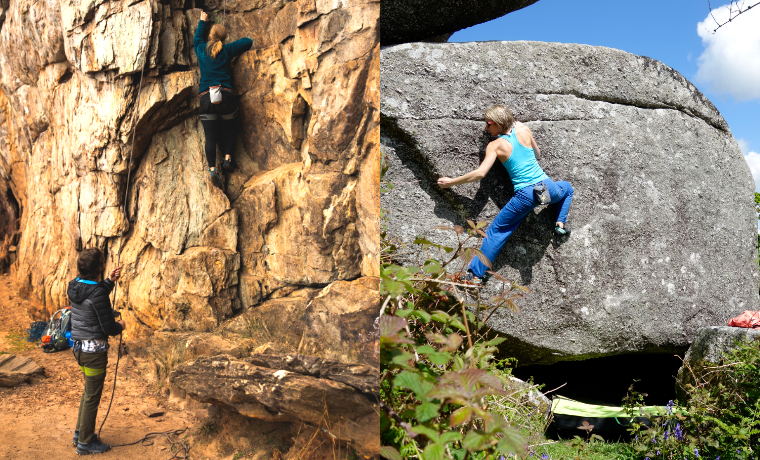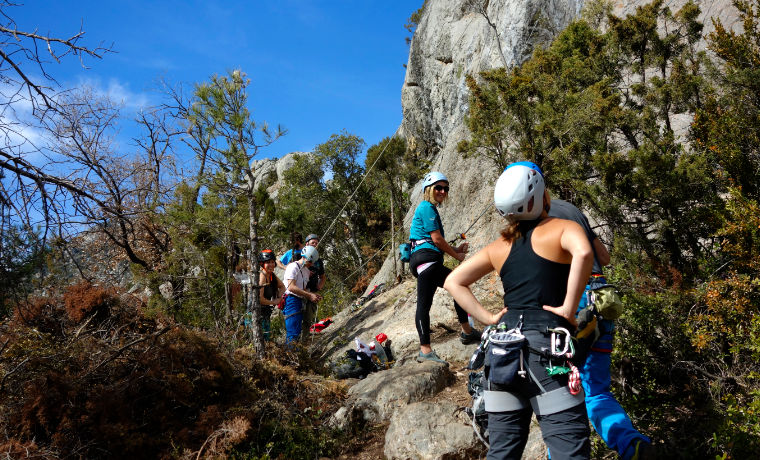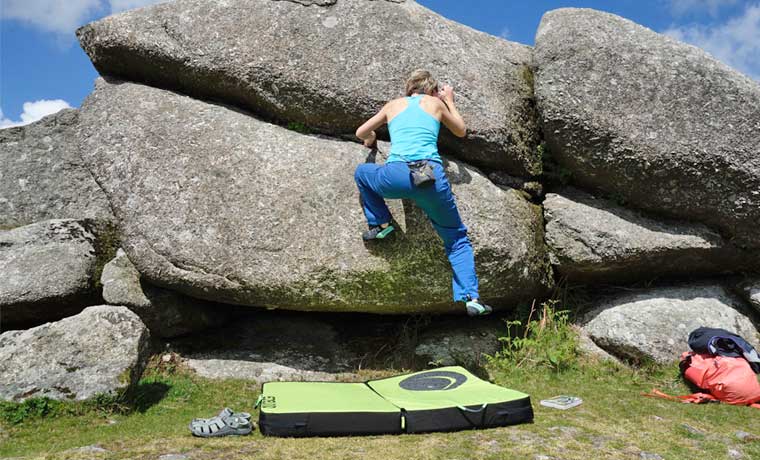Let’s begin by saying this is not a report of a fight between Rock Climbing in one corner of the ring and Bouldering in the other … or Mr Quick Draw vs Mr Beanie Hat! There is no competition. There will be no winner in the rock climbing vs bouldering discussion. The title is also misleading in that bouldering is a form of rock climbing, so it would be a little like a rock climber hitting himself over the head with a crash pad!
Instead, and more helpfully, the article will highlight the essential differences between rock climbing – particularly roped free climbing – and bouldering. It will look at style, equipment, mental and physical skills, as well as accessibility and sociability. If you’re a beginner, you’ll also learn which one is likely to suit you best.
- Rock climbing vs bouldering: what are the key differences?
- Rock climbing vs bouldering: style
- Rock climbing vs bouldering: equipment (performance and safety)
- Rock climbing vs bouldering: mental skills
- Rock climbing vs bouldering: physical skills / body types
- Rock climbing vs bouldering: accessibility
- Rock climbing vs bouldering: sociability
- Rock climbing vs bouldering: which is best for beginners?
Rock climbing vs bouldering: what are the key differences?
Starting with bouldering, as it has a narrower definition, it’s a category of unroped climbing on short routes (around 4-5m in height) above crash pads that offer protection from falls. It can be done indoors on plastic holds attached to the wall, or outdoors on real rock, using natural features to get to the top. The routes are called problems, in that they tend to take multiple attempts to solve.
Rock climbing though is an umbrella term for a range of different climbing types, all neatly explained for you here: types of rock climbing. But for the purposes of this article, I will be ignoring the more esoteric forms of rock climbing, namely aid climbing, free soloing and deep-water soloing. Instead, I will focus only on roped free climbing, where you climb a high indoor wall or rockface whilst attached to a rope and a belayer to catch you if you fall.
However, I’m afraid it’s not as simple as that! Roped free climbing is further subdivided into top roping, where the rope runs above your head to an anchor and tightens as you climb; and lead climbing, where you protect yourself as you climb by attaching the rope either to quickdraws and bolts (sport climbing) or gear you place yourself (trad climbing).
To summarise as succinctly as possible, just remember the following:
-
Bouldering = low, no rope.
- Rock climbing = high, rope.
Rock climbing vs bouldering: style
The main factor that determines the style of rock climbing vs the style of bouldering is the height of the route. For the longer routes in rock climbing, it is necessary to have greater endurance and, like a marathon runner, the rock climber will move at a slower pace. And to continue the analogy, the boulderer, like a sprinter, tends to climb in a more explosive and powerful style.
Lead rock climbing also takes more time because of the need to pull up the rope and clip into bolts or gear, which must all be done in a controlled and balanced fashion so as to minimise risk. Boulderers, on the contrary, do not need to pause to worry about protection, and will therefore attempt to flow from one hold to the next.
Another factor that affects style is the relative degree of difficulty for individual moves. If you become both a rock climber and boulderer, you will lunge for smaller or more suspect holds when bouldering which you’d never consider when high above gear on a trad route.
Also, boulderers tend to try a problem many times before they succeed, which means they become more and more familiar with each move, and therefore their style invariably becomes smoother. However, rock climbers, especially trad, prefer to climb a route on the first attempt – called an onsight or flash – which, whether successful or not, is likely to lack fluidity.

Rock climbing vs bouldering: equipment (performance and safety)
The equipment climbers use can be divided into items that improve performance and items that protect you from injury. In the former category, there is no difference between rock climbing and bouldering: both use climbing shoes and chalk that increase the stickiness of your feet and hands respectively. But when it comes to safety, there are significant differences between the two.
For top roping – the simplest form of roped climbing – you still need the minimum of rope, harness, belay device and carabiners. But for lead climbing, you will also need numerous quickdraws, as well as slings, nuts and cams for trad routes. Most climbers also wear helmets to protect themselves from loose rock and from hitting their heads if they swing upside down.
Bouldering safety equipment, however, is not attached to you (and there’s a lot less of it to worry about). Instead, you rely on crash pads on the ground to soften your fall. Ideally, a spotter will also help by preventing you from rolling backwards off the pad when you land.

Rock climbing vs bouldering: mental skills
All climbing, whether rock climbing or pure bouldering, needs a degree of mental confidence in order to gain height. You must be brave enough to put yourself in a situation where a fall could hurt. But the potential falls vary between the disciplines.
Top roping is the safest form of climbing with the lowest risk of injury, and therefore should need the least amount of bravery. Your belayer is solely responsible for your safety, and if you fall on a tight top rope, you will barely move. Having said that, you can still be a long way off the ground when top roping, so you must be able to cope with the height and the perceived, if not real, danger of injury through falling.
Lead climbing is more taxing mentally. The climber must climb and clip herself into the wall; protection from a fall is therefore a joint effort between the climber and belayer. Also, if you come off the wall 2m above your last piece of protection, you will fall 4m plus any rope stretch. When trad climbing, the fall could be much longer than this, and there is the added worry of gear ripping if it isn’t placed correctly! Lead climbers have to manage this risk, and while it can be mitigated by climbing routes below your limit, a calm mind helps. Panic and lead climbing do not mix!
Boulderers do not have to worry about extreme height and long falls, and the more crash pads you have the safer you will feel. However, bouldering up to 5m can still feel scary, especially when topping-out and having to shift your centre of gravity over the lip of the boulder. If you are an indoor boulderer venturing outdoors for the first time, it will take you a little time to adjust mentally to the height, as well as to rocky and uneven landings and how small one or two crash pads can seem from the top of the boulder.
Rock climbing vs bouldering: physical skills / body types
Rock climbing in general is a difficult sport, which puts a significant strain on your body, especially your fingers. All climbers therefore need a good base level of fitness, and not to be carrying too much excess weight.
Bouldering in particular, even easy problems, requires strong fingers, as well as good balance and flexibility. But that doesn’t mean you must be genetically strong. As long as you take your time and not push yourself too hard on your early sessions, then your finger strength will develop.
Rock climbing on hard routes also requires considerable strength, along with endurance. But – and this is the welcome news for the weaker readers out there! – you do not need to climb hard routes; as much fun and fulfilment can be had at the crag by climbing easier routes that put less stress on your body. This is especially true in trad climbing where low-grade routes have lots of opportunities to rest and where most of the weight can be placed on your feet. Also, age is less of a barrier in trad climbing; go to Stanage Edge in the Peak District and you’ll see many climbers in their 50s and 60s!

Rock climbing vs bouldering: accessibility
Indoor climbing is a popular and growing sport, with new centres continuing to pop up around the country. Indoor bouldering and indoor roped climbing are both therefore very accessible in that you only need to turn up, pay your fee, pass a quick induction, and then you’re able to climb in all weather conditions.
However, for roped climbing, you would not be able to pass your induction without first knowing how to put on a harness, tie a figure of eight knot and belay safely. It can either be learned on a quick course or taught by a friend. Bouldering indoors though is more accessible as these skills are not required.
For outdoor climbing, bouldering again is more accessible due to the minimal equipment you need, but I would recommend accompanying a more experienced boulderer for your first few trips in order to be shown where to go and how to place the crash pads. Many outdoor bouldering crags also have the advantage of being closer to the road, so the approach is shorter and generally more accessible.
Outdoor rock climbing on the contrary can often involve long walks to reach the crag, which means you need to allocate more time – possibly a whole day – before you get back to the car. And then there is all the equipment, especially the trad gear, that must be mastered before you can safely climb: this fact alone makes outdoor rock climbing much less accessible than bouldering.

Rock climbing vs bouldering: sociability
Both rock climbing and bouldering are social activities, but in different ways. Rock climbers come in twos, with one person climbing and the other belaying. It is very much a partnership and if you climb long enough with a regular partner, you will build a deep sense of trust and companionship. And while you spend most of your time on either end of a rope, there is still a lot of opportunity to chat on the way to the crag, when gearing up, in between routes, as well as debriefing in the evening.
Boulderers can also be seen in twos, taking it in turns to try the problem, but the discipline also lends itself to large groups, sharing pads and sharing ideas. It is one of the most sociable forms of climbing as boulderers spend a considerable amount of time sitting on the pads, supposedly resting their fingers between attempts, but really just chatting and enjoying the location and each other’s company!
At the other end of the spectrum, bouldering can also be done alone. As long as you’re comfortable climbing above the number of pads you’re able to carry yourself, then it’s a safe, quiet and peaceful way to spend a few hours.

Rock climbing vs bouldering: which is best for beginners?
The answer to this question depends on the points raised above. If you have no stamina, for example, you probably want to start with bouldering. If you’re scared of heights and can never untangle rope, then bouldering is also for you. But if you love long days out in the mountains and playing with shiny pieces of kit, then trad climbing is calling!
Accessibility and equipment are probably the two most important determining factors for beginners to consider. And bouldering comes out on top in both, being more accessible and with minimal equipment. There is less to learn to start bouldering indoors, and a lot less equipment is required to go outdoors; crash pads can be borrowed or shared too, if you don’t want to invest or have the space in your car.
But while rope climbing, especially trad, might have a longer learning curve, needing more of your time to reach a good level of competency, it is definitely worth the effort – stick with it!
Final thoughts
So as I said at the start, there is no winner in the battle between rock climbing and bouldering. Whether you wish to climb with a rope or above a crash pad, you will experience the same wonderful feeling of moving your body in the vertical plane, of challenging yourself mentally and physically. The choice is up to you and hopefully you’re now more informed to decide which climbing type suits you best. But if in doubt, try them all!
The post Climbing Vs Bouldering: Which One Is For You? appeared first on Cool of the Wild.


